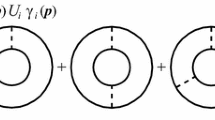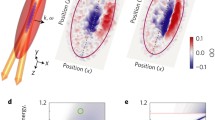Abstract
The study of ultracold Fermi gases has exploded a variety of experimental and theoretical research since the achievement of degenerate quantum gases in the lab, which expands the research range over atomic physics, condensed matter physics, astrophysics and particle physics. Using the Feshbach resonance, one can tune the attractive two-body interaction from weak to strong and thereby make a smooth crossover from the BCS superfluid of cooper pairs to the Bose Einstein condensate of bound molecules. In this crossover regime, the pairing effect plays a significant role in interpreting the interaction mechanism. Whenever the localized or delocalized pairing occurs at sufficiently low temperature, the single-particle energy will shift with respect to free atoms, due to the two-body or many-body interaction. Measuring the pairing gap can improve the understanding of the thermodynamics and hydrodynamics of the phase transition from the pseudogap to the superfluid, which will make an analogue to the high-temperature superconductivity in condensed matter. In this work, we will give a brief introduction to a novel radio-frequency (RF) spectroscopic measurement for pairing gap in an ultracold Fermi gas, which is currently widely used on the ultracold atomic table in the lab. In different interaction regimes of the BEC-BCS crossover, ultracold atoms are excited with a RF pulse and the characteristic behavior can be extracted from the spectrum.
Similar content being viewed by others
References
DeMarco B, Jin D S. Onset of Fermi degeneracy in a trapped atomic gas. Science, 1999, 285: 1703–1706
Giorgini S, Pitaevskii L P, Stringari S. Theory of ultracold atomic Fermi gases. Rev Mod Phys, 2008, 80(4): 1215–1274
Cooper L N. Bound electron pairs in a degenerate Fermi gas. Phys Rev, 1956, 104(4): 1189–1190; Bardeen J, Cooper L N, Schrieffer J R. Theory of superconductivity. Phys Rev, 1957, 108 (5): 1175–1204
Melo C A R S D. When bosons become fermions: Pairing in ultracold gases. Phys Tod, 2008, 61: 45–51
Chin C, Rudolf G, Paul J, et al. Feshbach resonances in ultracold gases. Rev Mod Phys, 2010, 82(2): 1225–1286
Zhang W, Sackett C A, Hulet R G. Optical detection of a Bardeen-Cooper-Schrieffer phase transition in a trapped gas of fermionic atoms. Phys Rev A, 1999, 60(1): 504–507; Weig F, Zwerger W. Optical detection of a BCS transition of lithium-6 in harmonic traps. Europhys Lett, 2000, 49: 282–288
Torma P, Zoller P. Laser probing of atomic Cooper pairs. Phys Rev Lett, 2000, 85(3): 487–490
Nascimbene S, Nir N, Jiang K J, et al. Collective oscillations of an imbalanced Fermi gas: Axial compression modes and polaron effective mass. Phys Rev Lett, 2009, 103(17): 170402; Bartenstein M, Altmeyer A, Riedl S, et al. Collective excitations of a degenerate gas at the BEC-BCS crossover. Phys Rev Lett, 2004, 92 (20): 203201
Gupta S, Hadzibabic Z, Zwierlein M W, et al. Radio-frequency spectroscopy of ultracold fermions. Science, 2003, 300: 1723–1726
Chin C, Bartenstein M, Altmeyer A, et al. Observation of the pairing gap in a strongly interacting Fermi gas. Science, 2004, 305: 1128–1130
Regal C A, Ticknor C, Bohn J L, et al. Creation of ultracold molecules from a Fermi gas of atoms. Nature, 2003, 424: 47–50
Zirbel J J, Ni K K, Ospelkaus S, et al. Heteronuclear molecules in an optical dipole trap. Phys Rev A, 2008, 78(1): 013416
Regal C A, Jin D S. Measurement of positive and negative scattering lengths in a Fermi gas of atoms. Phys Rev Lett, 2003, 90(23): 230404
Schunck C H, Shin Y, Andre S, et al. Determination of the fermion pair size in a resonantly interacting superfluid. Nature, 2008, 454: 739–744
Shin Y, Schunck C H, Schirotzek A, et al. Tomographic rf spectroscopy of a trapped Fermi gas at unitarity. Phys Rev Lett, 2007, 99(9): 090403
Schirotzek A, Shin Y, Schunck C H, et al. Determination of the superfluid gap in atomic Fermi gases by quasiparticle spectroscopy. Phys Rev Lett, 2008, 101(14): 140403
Larkin A I, Ovchinnikov Y N. Inhomogeneous state of superconductors. Sov Phys JETP, 1965, 20: 762–769; Fulde P, Ferrell R A. Superconductivity in a strong spin-exchange feld. Phys Rev, 1964, 135: A550–A563
Liao Y, Rittner A S C, Paprotta T, et al. Spin-imbalance in a one-dimensional Fermi gas. Nature, 2010, 467(7315): 567–569
Buchanan M. Mind the pseudogap. Nature, 2001, 409(6816): 8–11
Schirotzek A, Cheng-Hsun W, Ariel S, et al. Observation of Fermi polarons in a tunable Fermi liquid of ultracold atoms. Phys Rev Lett, 2009, 102(23): 230402
Stewart J T, Gaebler J P, Jin D S. Using photoemission spectroscopy to probe a strongly interacting Fermi gas. Nature, 2008, 454: 744–747
Nascimbene S, Navon N, Jiang K J. et al. Exploring the thermodynamics of a universal Fermi gas. Nature, 2010, 463: 1057–1061
Gaebler J P, Stewart J T, Drake T E, et al. Observation of pseudogap behaviour in a strongly interacting Fermi gas. Nat Phys, 2010, 6: 569–573
Bloch I, Dalibard J, Zwerger W. Many-body physics with ultracold gases. Rev Mod Phys, 2008, 80(3): 885–964
Kohstall C, Zaccanti M, Jag M, et al. Metastability and coherence of repulsive polarons in a strongly interacting Fermi mixture. Nature, 2012, 485: 615–619; Zhang Y, Hazlett E L, Stites R W, et al. Realization of a resonant Fermi gas with a large effective range. Phys Rev Lett, 2012, 108 (4): 045304
Liao R, Yi X Y, Liu W M. Tuning the tricritical point with spin-orbit coupling in polarized Fermionic condensates. Phys Rev Lett, 2012, 108(8): 080406
Jiang S J, Yu X L, Liu W M. Imbalanced ultracold Fermi gas in the weakly repulsive regime: Renormalization-group approach for p-wave superfluidity. Phys Rev A, 2011, 84(6): 063608
Author information
Authors and Affiliations
Corresponding author
Rights and permissions
About this article
Cite this article
Jiang, K., Luo, H., Li, K. et al. Radio-frequency spectroscopic measurement for pairing gap in an ultracold Fermi gas. Sci. China Phys. Mech. Astron. 56, 581–587 (2013). https://doi.org/10.1007/s11433-012-4936-x
Received:
Accepted:
Published:
Issue Date:
DOI: https://doi.org/10.1007/s11433-012-4936-x




